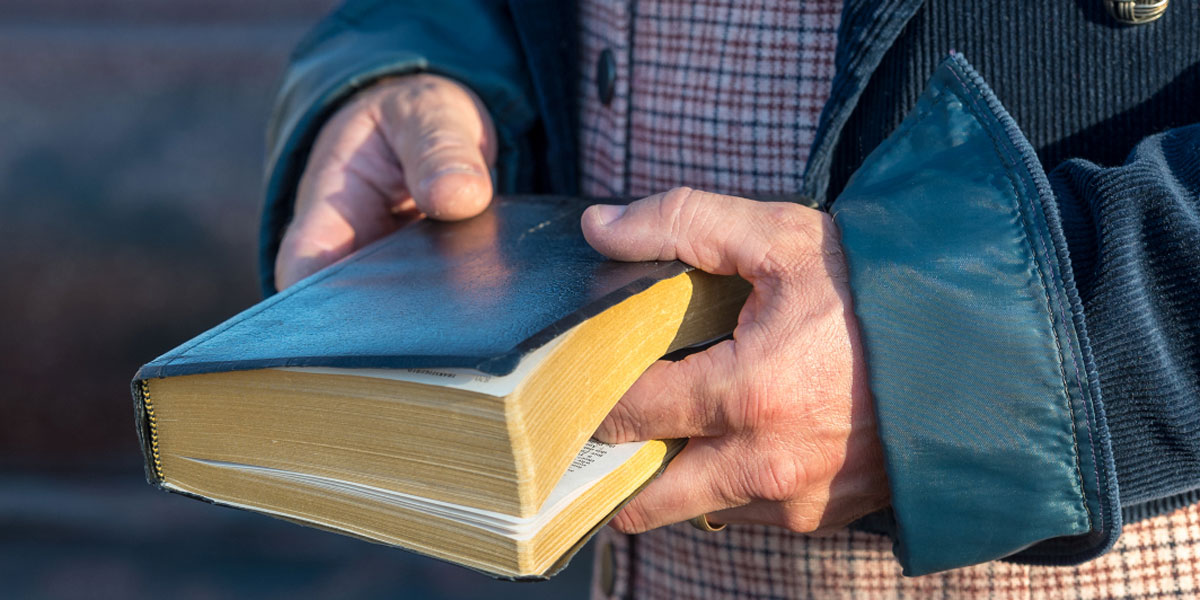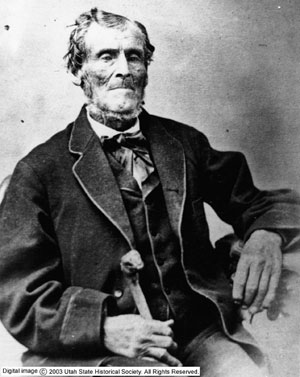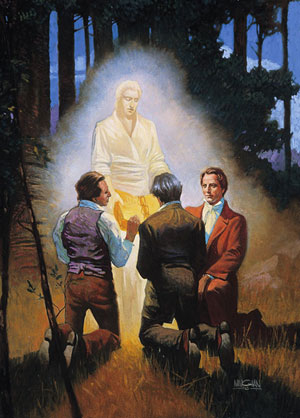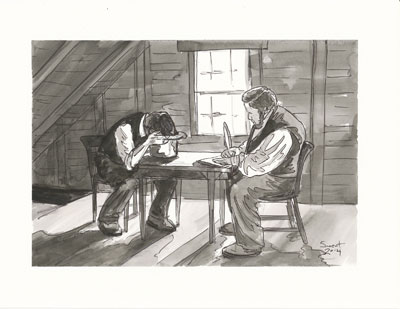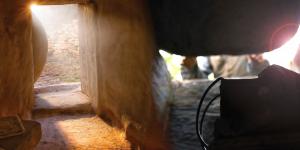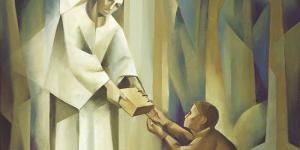You are here
How Did Martin Harris Help Bring Forth the Book of Mormon?

2 Nephi 27:15
The Know
A successful farmer and businessman from a prominent Palmyra family,1 Martin Harris may have been Joseph Smith’s earliest supporter outside of his own family.2 Yet he tends to be remembered by Latter-day Saints as a “wicked man” for losing the 116 manuscript pages (Doctrine and Covenants 3:12; 10:1, 7).3 Martin, however, contributed lots more to the coming forth of the Book of Mormon than many may realize.4
Martin served as Joseph’s scribe for two full months (April 12–June 14, 1828) before losing the initial manuscript.5 During this time, Martin remembered once switching out Joseph’s seer stone with a rock of similar shape, size, and color as a test, “to stop the mouths of fools” who claimed Joseph had merely memorized the sentences he was dictating ahead of time. Upon looking into the hat, Joseph said it was “dark as Egypt” and he could not translate, proving to Martin that Joseph was divinely inspired.6
Before becoming a scribe, Martin carefully interrogated each member of the Smith family individually, and he hefted the plates while locked in a wooden box.7 Martin determined that the plates were either “lead or gold,” and knew that Joseph “had not enough credit to buy so much lead.”8 Known for his “shrewd business practices,”9 Martin only lent his support after giving the Smiths’ story careful scrutiny.
“In the fall of 1827,” reported Rhett Stephens James, Martin “helped Joseph Smith protect the plates from thieves.”10 Martin remembered an occasion when he held the plates on his knee for an hour and half while helping Joseph hide them in the woods.11 Martin ultimately provided the financial assistance Joseph needed to move from Palmyra, NY to Harmony, PA, where Joseph was able to escape those who would try to steal the plates.12
In February 1828, Martin took copies of the script written on the plates back east to learned men like Luther Bradish, Samuel L. Mitchill, and Charles Anthon to see if they could authenticate the script and potentially translate it.13 Martin remembered Anthon refusing to affirm the antiquity of the script after learning of the miraculous origins and that the plates were partially sealed, declaring, “I cannot read a sealed book.”14 Joseph recognized that this experience with Anthon fulfilled an important prophecy (2 Nephi 27:15–18; cf. Isaiah 29:11).15
Even after losing the manuscript, Martin remained interested in Joseph’s progress and tried to assist him in whatever ways he could. In March 1829, Martin was the first of all the witnesses to be promised a chance to view the plates. While Martin had remained supportive, he still desired a “greater witness.”16 As a result, the Lord revealed that there would be three witnesses, and Martin could be one of them—if he humbled himself and had faith (Doctrine and Covenants 5). A few months later, Martin Harris joined Oliver Cowdery and David Whitmer as one of the Three Witnesses of the Book of Mormon.17
Despite his personal struggle to exercise the necessary faith, the Lord had chosen Martin as a witness.18 Once Martin saw the angel and the plates, he remained a faithful witness until his death in 1875. After receiving the vision, Martin excitedly exclaimed, “tis enough mine eyes have beheld!” Even over the course of several decades estranged from the Church he actively testified of the Book of Mormon—even making a trip to England for that purpose.19
Finally, when it came time to print the Book of Mormon, Martin was the only one who could provide the funding needed to print the large, expensive run of 5000 copies. At great personal sacrifice, Martin mortgaged most of his farm to cover the $3000 costs E.B. Grandin required upfront.20 In western New York, 1829 was a time of economic hardship, meaning, “Martin Harris’s financial sacrifices for the printing of the Book of Mormon could not have come at a worse time, economically.”21
The Why
The personal sacrifices of Martin Harris to assist in getting the Book of Mormon translated and published, and his lifelong faithfulness to his calling as a witness of the Nephite record, should not be overshadowed by his mistakes or moments of skepticism and doubt. If anything, his frequent questioning should make his steady witness of the plates over the course of several decades all the more compelling.
Martin’s tangible experiences, like hefting the plates in a wooden box and letting them rest on his knee, go along with his more miraculous manifestations of the angel with the plates and the voice from heaven declaring their truth. He frequently tested the prophet—taking copies of the script to scholars, switching out the seer stone—providing experiences that fulfilled prophecy and assured him of Joseph’s divine calling.
His overall combined set of experiences convinced him—a shrewd businessman—to fund the printing of the book at great personal sacrifice financially, during a time of economic difficulty. As Matthew McBride explained, “By so doing, he secured his place as the most significant financial supporter of the Book of Mormon and thus the early Church. None among Joseph Smith’s younger and poorer friends could have provided this critical contribution.”22
Although Martin lost the first 116 pages, it was through his sacrifice that the rest of the text—over 500 pages in length—was published and made available to the world. Understanding that no one else could have provided the necessary funding to print the book should invoke the gratitude of all who read the Book of Mormon today.
In 1870, Martin would become the only one of all the Book of Mormon witnesses to come to Utah.23 There, he lived out his final years testifying of the Book of Mormon and telling the story of its coming forth to all who would listen. His son, Martin Harris Jr., remembered him testifying of the Book of Mormon with his last audible words.24 Martin’s experiences eventually convinced him of the divine origins of the Book of Mormon, and his overall experience remains convincing today for many who study the life of this cautious witness.
Further Reading
John W. Welch, “The Miraculous Timing of the Translation of the Book of Mormon,” in Opening the Heavens: Accounts of Divine Manifestations, 1820–1844, ed. John W. Welch, 2nd edition (Salt Lake City and Provo, UT: Deseret Book and BYU Press, 2017), 145–156, primary documents nos. 44–68.
Matthew McBride, “The Contributions of Martin Harris,” in Revelations in Context: The Stories Behind the Sections of the Doctrine and Covenants (Salt Lake City, UT: The Church of Jesus Christ of Latter-day Saints, 2016), 1–9.
Michael Hubbard MacKay and Gerrit J. Dirkmaat, From Darkness unto Light: Joseph Smith’s Translation and Publication of the Book of Mormon (Salt Lake City and Provo, UT: Deseret Book and Religious Studies Center, Brigham Young University, 2015), 39–59, 79–104, 181–197.
Richard E. Bennett, “Martin Harris and Three Wise Men,” BYU Speeches, June 29, 2010, online at speeches.byu.org.
Susan Easton Black and Larry C. Porter, “‘For the Sum of Three Thousand Dollars’,” Journal of Book of Mormon Studies 14, no. 2 (2005): 4–11, 66–67.
Richard Lloyd Anderson, Investigating the Book of Mormon Witnesses (Salt Lake City, UT: Deseret Book, 1981), 95–120.
- 1. For Martin’s reputation among his neighbors in his pre-Mormon years, see Richard Lloyd Anderson, Investigating the Book of Mormon Witnesses (Salt Lake City, UT: Deseret Book, 1981), 95–105.
- 2. See Ronald W. Walker, “Martin Harris: Mormonism’s Early Convert,” Dialogue: A Journal of Mormon Thought 19, no. 4 (Winter 1986): 29–43.
- 3. For context on these revelations, see Steven C. Harper, Making Sense of the Doctrine and Covenants: A Guided Tour through the Revelations (Salt Lake City, UT: Deseret Book, 2008), 24–28, 46–50. For an assessment of what we do and don’t know about this incident, see J.B. Haws, “The Lost 116 Pages Story: What We Do Know, What We Don’t Know, and What We Might Know,” in The Coming Forth of the Book of Mormon: A Marvelous Work and a Wonder, ed. Dennis L. Largey, Andrew H. Hedges, John Hilton III, and Kerry Hull (Salt Lake City and Provo, UT: Deseret Book and Religious Studies Center, Brigham Young University, 2015), 81–102. See also Susan Easton Black, “Book of Mormon, lost manuscript of (116 pages),” in Book of Mormon Reference Companion, ed. Dennis L. Largey (Salt Lake City, UT: Deseret Book, 2003), 123–124.
- 4. See Richard Lyman Bushman, Joseph Smith: Rough Stone Rolling (New York, NY: Knopf, 2005), 61–69 for a review of Martin’s early involvement before losing the manuscript. For a chronology of events before the loss of the manuscript, see John W. Welch, “The Miraculous Timing of the Translation of the Book of Mormon,” in Opening the Heavens: Accounts of Divine Manifestations, 1820–1844, ed. John W. Welch, 2nd edition (Salt Lake City and Provo, UT: Deseret Book and BYU Press, 2017), 85–95.
- 5. Welch, “The Miraculous Timing of the Translation,” 94–95. For more on this period, see Michael Hubbard MacKay and Gerrit J. Dirkmaat, From Darkness unto Light: Joseph Smith’s Translation and Publication of the Book of Mormon (Salt Lake City and Provo, UT: Deseret Book and Religious Studies Center, Brigham Young University, 2015), 79–104.
- 6. “The Three Witnesses of the Book of Mormon,” Millennial Star 48, June 21, 1886, 390. See also, Matthew McBride, “The Contributions of Martin Harris,” in Revelations in Context: The Stories Behind the Sections of the Doctrine and Covenants (Salt Lake City, UT: The Church of Jesus Christ of Latter-day Saints, 2016), 4–6.
- 7. See MacKay and Dirkmaat, From Darkness unto Light, 26–30. Martin’s wife and daughter also hefted the plates while in the box, which may have spurred his own interest to investigate further.
- 8. Joel Tiffany, “Mormonism—No. II,” Tiffany’s Monthly 5, August 1859, 169–170.
- 9. Rhett Stephens James, “Harris, Martin,” in Encyclopedia of Mormonism, 4 vols., ed. Daniel H. Ludlow (New York, NY: Macmillan, 1993), 2:574.
- 10. Rhett Stephens James, “Harris, Martin,” in Encyclopedia of Latter-day Saint History, ed. Arnold K. Garr, Donald Q. Cannon, and Richard O. Cowen (Salt Lake City, UT: Desert Book, 2000), 468.
- 11. “Testimonies of Oliver Cowdery and Martin Harris,” Millennial Star 21, August 20, 1859, 545. The testimony of Martin Harris in this article comes from a transcript written by Elder D. B. Dille dated to September 15, 1853. Martin also helped hide them in a barrel of beans as Joseph prepared to depart toward Harmony. See MacKay and Dirkmaat, From Darkness unto Light, 32.
- 12. McBride, “The Contributions of Martin Harris,” 2.
- 13. For background on this trip, see Richard E. Bennett, “Martin Harris and Three Wise Men,” BYU Speeches, June 29, 2010, online at speeches.byu.org; Richard E. Bennett, “‘Read This I Pray Thee’: Martin Harris and the Three Wise Men of the East,” Journal of Mormon History 36, no. 1 (Winter 2010): 178–216; Richard E. Bennett, “‘A Nation Now Extinct,’ American Indian Origin Theories as of 1820: Samuel L. Mitchill, Martin Harris, and the New York Theory,” Journal of Book of Mormon Studies and Other Restoration Scripture 20, no. 2 (2011): 30–51; Richard E. Bennett, “Martin Harris’s 1828 Visit to Luther Bradish, Charles Anthon, and Samuel Mitchill,” in The Coming Forth of the Book of Mormon, 103–115; Richard E. Bennett, “‘A Very Particular Friend’: Luther Bradish,” in Approaching Antiquity: Joseph Smith and the Ancient World, ed. Lincoln Blumell, Matthew J. Grey, and Andrew H. Hedges (Salt Lake City and Provo, UT: Deseret Book and Religious Studies Center, Brigham Young University, 2015), 63–82; Michael Hubbard MacKay, “‘Git Them Translated’: Translating the Characters on the Gold Plates,” in Approaching Antiquity, 83–116; MacKay and Dirkmaat, From Darkness unto Light, 39–59.
- 14. McBride, “The Contributions of Martin Harris,” 3–4. Charles Anthon was occasionally asked about Martin’s visit, but remembered things differently. See Erin B. Jennings, “Charles Anthon—The Man Behind the Letters,” John Whitmer Historical Association Journal 32, no. 2 (2012): 171–187. For a review of inconsistencies in two of Anthon’s accounts, see Robert F. Smith, Gordon C. Thomasson, and John W. Welch, “What Did Charles Anthon Really Say?” in Reexploring the Book of Mormon: A Decade of New Research, ed. John W. Welch (Salt Lake City and Provo, UT: Deseret Book and FARMS, 1992), 73–75. See also Robert F. Smith, Gordon C. Thomasson, and John W. Welch, “Martin Harris’s Visit with Charles Anthon: Collected Documents on the Anthon Transcript and ‘Shorthand Egyptian’,” (FARMS Preliminary Reports, 1990).
- 15. While Nephi clearly borrowed heavily from Isaiah 29, it is important to recognize that Nephi was making his own prophecy in 2 Nephi 25–30, and thus 2 Nephi 27 and Isaiah 29 are two different prophecies. See Book of Mormon Central, “Why Does Nephi Use Isaiah 29 as Part of His Own Prophecy? (2 Nephi 26:16; cf. Isaiah 29:4),” KnoWhy 52 (March 11, 2016).
- 16. Harper, Making Sense of the Doctrine and Covenants, 31; McBride, “The Contributions of Martin Harris,” 6–7.
- 17. Book of Mormon Central, “Why Were Three Key Witnesses Chosen to Testify of the Book of Mormon? (Ether 5:4),” KnoWhy 267 (January 27, 2017).
- 18. The three witnesses along with Joseph Smith went out into the woods and prayed together seeking the divine manifestation promised. After multiple failed attempts, Martin blamed himself and withdrew, after which David Whitmer, Oliver Cowdery, and Joseph Smith received a vision of the angel and the plates. Joseph then sought out Martin, and found him praying on his own. Joseph and Martin then had the same vision. See McBride, “The Contributions of Martin Harris,” 7; MacKay and Dirkmaat, From Darkness unto Light, 149–151.
- 19. Anderson, Investigating the Book of Mormon Witnesses, 107–120. The trip to England was as a missionary with a leader in the James Strang Mormon break-off group. However, while there it was discovered that he did not actually support the Strangite cause and was only there to testify of the Book of Mormon. As a result, the Strangite leaders would not allow him to speak at gatherings and publicly repudiated him (see pp. 112–113).
- 20. See Susan Easton Black and Larry C. Porter, “‘For the Sum of Three Thousand Dollars’,” Journal of Book of Mormon Studies 14, no. 2 (2005): 4–11, 66–67; MacKay and Dirkmaat, From Darkness unto Light, 181–197.
- 21. Bennett, “A Very Particular Friend,” 68–69.
- 22. McBride, “The Contributions of Martin Harris,” 8.
- 23. For an account of how Martin eventually came to Utah, see Susan Easton Black and Larry C. Porter, “‘Rest Assured, Martin Harris Will Be Here in Time’,” Journal of the Book of Mormon and Other Restoration Scripture 20, no. 1 (2011): 5–27; also published in Bountiful Harvest: Essays in Honor of S. Kent Brown, ed. Andrew C. Skinner, D, Morgan Davis, and Carl Griffin (Provo, UT: Neal A. Maxwell Institute for Religious Scholarship, 2011), 31–71.
- 24. Martin Harris Jr. to George Albert Smith, printed in The Witnesses of the Book of Mormon, comp. Preston Nibley (Salt Lake City, UT: Deseret Book, 1968), 142: “He has continued to talk about and testify to the truth of the Book of Mormon, and was in his happiest mood when he could get somebody to listen to his testimony …. The last audible words he has spoken were something about the three witnesses of the Book of Mormon, but we could not understand what it was.”
KnoWhy Citation
Related KnoWhys
Subscribe
Get the latest updates on Book of Mormon topics and research for free

